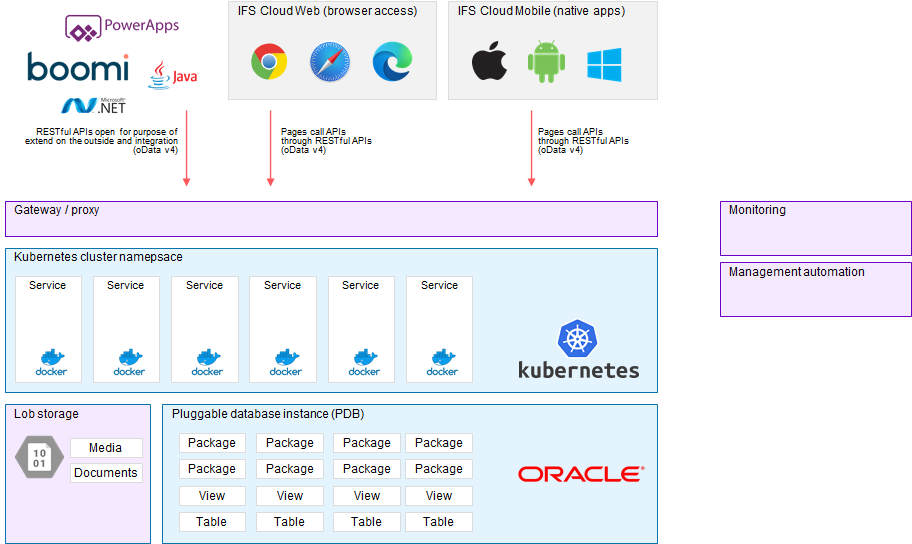Physical Architecture¶
The physical architecture of IFS Cloud consists of:
- Customer end user access using the various user experience options.
- Customer API access for integration and tailoring through extend-on-outside purposes.
- Core application services (in blue in the picture below), of which the main components are a Kubernetes cluster namespace running the platform services, and a pluggable Oracle database instance (PDB)
- Deployment model specific services (in pink in the picture below) for professional and secure operation of IFS Cloud, such as application gateways / firewalls, management automation and monitoring.

This architecture enables IFS Cloud to:
- Provide the same solution capabilities for both cloud and remote deployment models.
- Use the same services and code base in both deployment models.
- Cater for the different operational needs of IFS running a cloud service for thousands of customers vs. a customer running a single tenant of IFS Cloud in under the remote model.
With reference to the logical architecture, the database runs the storage tier and a large portion of the business logic tier. The Kubernetes cluster runs the API tier, chunks of the business logic tier, and most of the services in the platform tier. The presentation tier runs exclusively on end user devices in the browser or in the form of native mobile apps.
Cloud Deployment¶
For customer running in cloud deployment, the services depicted above are deployed per IFS Cloud tenant into an Azure region.
With the cloud deployment model being a full SaaS offering where the vendor (IFS) handles the operations of the IFS Cloud software there is little need for customers to know the the details of exactly how the deployment looks. That said a few basic facts can be good to know.
In a cloud deployment:
- All environments for a customer solution and tenant will be deployed to and operated in an Azure region.
- The environments belonging to one customer tenant are separated from environments belonging to another.
- Non-production environments are separated from the production environment.
Remote Deployment¶
The remote deployment model is used by customers who want to operate their IFS Cloud use place environment themselves. It also caters for air-gapped deployments in extremely high security scenarios. This model provides a pre-packaged setup for IFS Cloud running across three key servers.
- Database server running the Oracle database in the way supported by Oracle.
- Middle tier server running a pre-packaged Kubernetes cluster. Can be installed either on top of Ubuntu Linux or used as a pre-built OVM for VMWare.
- Management server is a smaller Windows server used to install and maintain (e.g. install deliveries) IFS Cloud on the remote deployment.
- (optional) Add-on sever used to host some specific IFS Cloud services, if they are included in the customer solution.
Both the database server as well as the middle tier server can be installed and used on a single node (virtual machine) or across multiple nodes for higher availability. The management server and add-on server can of course be VMs as well as physical servers.
Read more in the remote deployment guide.